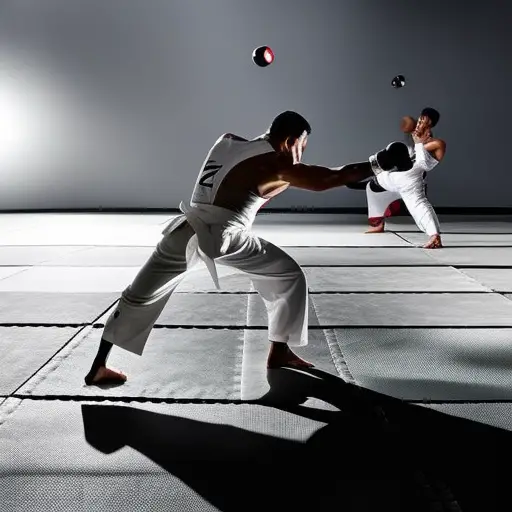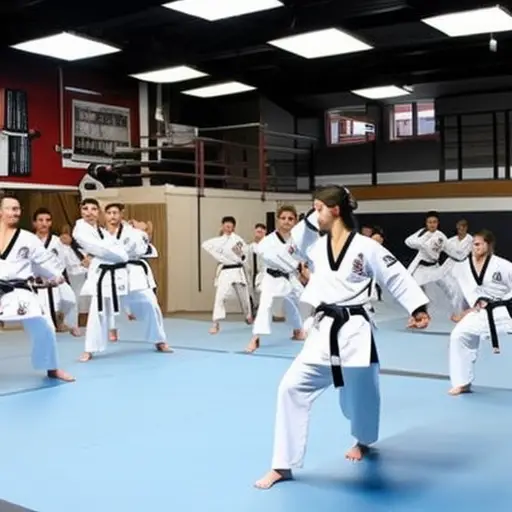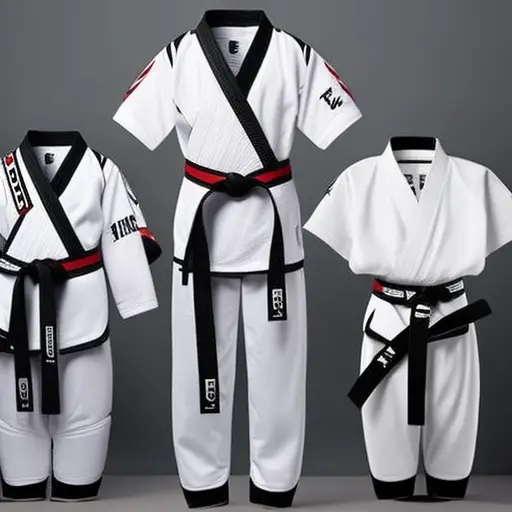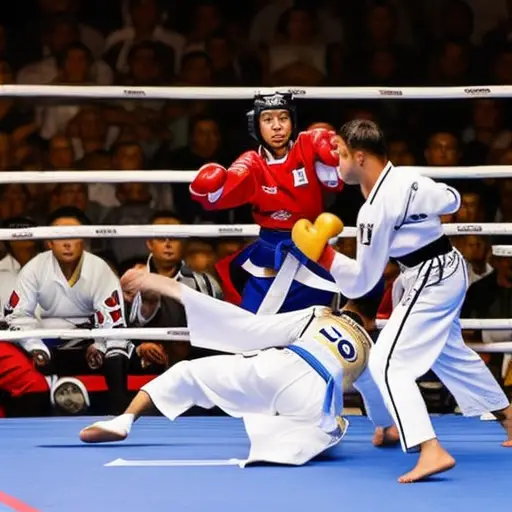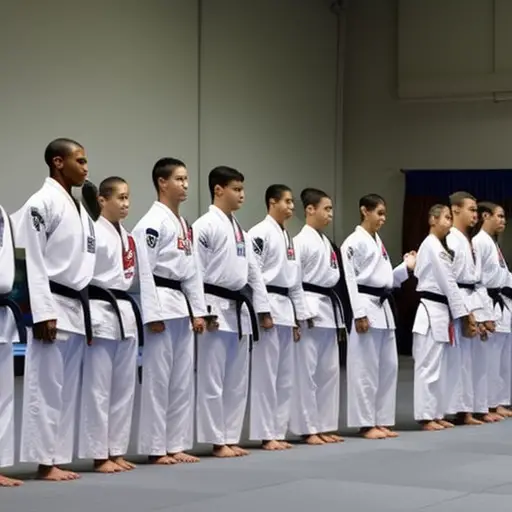Key Principles Every Taekwondo Practitioner Should Know

In the intricate dance of Taekwondo, practitioners must embrace the key principles that guide their journey towards mastery. Like a symphony conductor, they must wield the baton of discipline, conducting their bodies and minds towards excellence.
With each precise movement, they display the harmony and respect that defines this ancient art form. Through mental fortitude and unwavering focus, they cultivate the strength needed to overcome any obstacle.
Join us as we uncover the foundational principles that underpin the art of Taekwondo.
The Importance of Discipline in Taekwondo
One of the most crucial aspects of Taekwondo training is the strict adherence to discipline. Discipline is the foundation upon which all other skills and attributes are built. It is through discipline that practitioners learn to control their bodies, minds, and emotions. The benefits of discipline in Taekwondo are numerous.
Firstly, discipline helps in building self-confidence. By following a strict routine and adhering to the rules and regulations of Taekwondo, practitioners develop a sense of self-control and inner strength. This self-confidence extends beyond the training environment and can positively impact various aspects of life.
Moreover, discipline in Taekwondo teaches practitioners the importance of setting goals and working hard to achieve them. Through consistent training and dedication, individuals learn that success is not achieved overnight but requires discipline and perseverance.
Additionally, discipline fosters respect and humility. Practitioners learn to respect their instructors, fellow students, and the art of Taekwondo itself. They understand that discipline is necessary to maintain a safe and harmonious training environment.
Mastering Respect as a Taekwondo Practitioner
Respect is an essential attribute for every Taekwondo practitioner to master in order to cultivate a harmonious and honorable training environment. In the practice of Taekwondo, respect goes beyond simply showing deference to one’s instructors and fellow practitioners. It is a fundamental principle that extends to every aspect of a practitioner’s life.
Developing humility is a crucial aspect of mastering respect in Taekwondo. Humility allows practitioners to acknowledge their own limitations and weaknesses, fostering a sense of continuous growth and learning. By embracing humility, practitioners are able to approach their training with an open mind and a willingness to listen and learn from others.
Furthermore, respect in Taekwondo also involves fostering sportsmanship. Taekwondo is a competitive sport, and practitioners must learn to compete with integrity, fairness, and respect for their opponents. This means showing respect for the rules of the game, accepting victories and defeats with grace, and treating opponents with dignity and respect both on and off the mat.
Developing Mental Strength in Taekwondo
Developing a strong and resilient mindset is crucial for Taekwondo practitioners to excel in their training and overcome challenges. Taekwondo is not just about physical strength and techniques; it requires mental strength as well.
Here are three key principles for developing focus and building resilience in Taekwondo:
-
Mindfulness: Taekwondo training demands complete focus and concentration. Practitioners must learn to be fully present in each moment, aware of their body, breath, and surroundings. By cultivating mindfulness, they can enhance their mental clarity, reaction time, and overall performance.
-
Positive self-talk: Self-talk plays a significant role in shaping one’s mindset. Taekwondo practitioners should develop a habit of positive self-talk, using affirmations and constructive language to motivate themselves. By replacing negative thoughts with positive ones, they can boost their confidence, resilience, and belief in their abilities.
-
Mental conditioning: Building mental resilience in Taekwondo involves conditioning the mind to handle stress, setbacks, and pressure. Practitioners can achieve this through various techniques like visualization, goal setting, and mental rehearsals. By consistently practicing mental conditioning exercises, they can strengthen their ability to stay focused, composed, and determined, even in challenging situations.
The Role of Flexibility in Taekwondo Training
Enhancing flexibility is essential for maximizing performance and minimizing the risk of injuries in Taekwondo training. Flexibility training plays a crucial role in improving kicks, strikes, and movements, allowing practitioners to execute techniques with precision and power. Moreover, it helps to prevent muscle imbalances and joint restrictions, which can lead to strains and sprains.
To enhance flexibility effectively, Taekwondo practitioners should incorporate various stretching techniques into their training routine. Dynamic stretching, such as leg swings and arm circles, should be performed before engaging in vigorous activities to warm up the muscles and increase range of motion. Static stretching, on the other hand, involves holding a stretch for a prolonged period to improve flexibility and should be done after a workout to cool down the muscles.
The following table provides a comprehensive list of stretching techniques that can be utilized in Taekwondo training:
| Stretching Technique | Description | Benefits |
|---|---|---|
| Hamstring Stretch | Sit with legs extended and reach towards toes | Increases flexibility in the back of the legs |
| Quad Stretch | Stand and bring one heel towards the glutes | Improves flexibility in the front of the thigh |
| Calf Stretch | Stand and lean forward with one foot behind | Enhances flexibility in the calf muscles |
| Hip Flexor Stretch | Kneel and lunge forward with one leg | Increases flexibility in the hip flexors |
| Shoulder Stretch | Extend one arm across the chest and hold | Improves flexibility in the shoulder joint |
Achieving Balance in Taekwondo Techniques
To execute powerful and precise techniques, Taekwondo practitioners must maintain balance and coordination throughout their movements. Achieving balance is crucial in Taekwondo as it enables practitioners to generate maximum power while maintaining control and stability.
Here are three key principles to help Taekwondo practitioners achieve balance and enhance their techniques:
-
Strong stances: Taekwondo emphasizes the importance of solid stances, such as the front stance, back stance, and horse stance. These stances provide a strong foundation, allowing practitioners to maintain stability and generate power from the ground up. By mastering these stances, practitioners can achieve precision in their techniques.
-
Weight distribution: Proper weight distribution is essential for maintaining balance in Taekwondo. The weight should be evenly distributed between both legs, ensuring stability and agility during movements. By keeping the weight centered and distributed properly, practitioners can execute techniques with fluidity and accuracy.
-
Core strength: A strong and stable core is paramount in achieving balance in Taekwondo. The core muscles, including the abdominals, obliques, and lower back, provide the necessary support and control for all movements. By developing a strong core, practitioners can maintain fluidity in their techniques and minimize the risk of losing balance.
Understanding the Core Principles of Taekwondo Forms
During the practice of Taekwondo forms, it is important to understand and apply the core principles that govern their execution. One of these principles is understanding breathing techniques. Proper breathing is essential for maintaining focus, control, and power during the performance of forms. By synchronizing the breath with each movement, practitioners can enhance their concentration and flow, enabling them to execute the forms with precision and grace.
Another core principle of Taekwondo forms is the benefits of meditation. Forms provide an opportunity for practitioners to cultivate a calm and focused mind through the rhythmic movements and sequences. The repetitive nature of forms allows practitioners to enter a meditative state, enabling them to develop mental discipline and clarity. This mental aspect of forms complements the physical techniques, fostering a holistic approach to training.
Understanding the core principles of Taekwondo forms is crucial for practitioners to fully grasp the essence of this martial art. By incorporating breathing techniques and meditation into their practice, practitioners not only improve their physical execution but also enhance their mental and spiritual well-being. These principles set the foundation for the subsequent section on applying self-control in Taekwondo sparring.
Applying Self-Control in Taekwondo Sparring
Self-control is a fundamental aspect of Taekwondo sparring that every practitioner should prioritize.
Discipline plays a crucial role in maintaining composure during intense exchanges, allowing fighters to think clearly and make strategic decisions.
Additionally, controlling emotions effectively is essential in preventing unnecessary aggression and promoting a respectful and controlled environment on the mat.
Importance of Discipline
Maintaining discipline is essential for effective and controlled taekwondo sparring. Discipline in daily life and mental toughness development are crucial aspects of becoming a skilled taekwondo practitioner. Here are three key reasons why discipline plays a vital role in taekwondo sparring:
-
Improved Focus: Discipline helps practitioners stay focused during sparring sessions, enabling them to react quickly and make split-second decisions. It allows them to concentrate on their opponent’s movements and respond appropriately.
-
Enhanced Self-Control: Discipline instills self-control, preventing practitioners from succumbing to anger or frustration during sparring. It helps them maintain composure and make calculated moves, ensuring the sparring session remains controlled and safe.
-
Increased Resilience: Discipline develops mental toughness, allowing practitioners to push through physical and mental challenges they may encounter during sparring. It builds their resilience and determination, enabling them to persevere and overcome obstacles.
Controlling Emotions Effectively
One essential aspect of effective taekwondo sparring is the ability to effectively control emotions, using self-control and maintaining a calm demeanor.
Effective anger management and maintaining focus under pressure are crucial in taekwondo sparring. Emotions such as anger, fear, or frustration can hinder a practitioner’s performance and lead to poor decision-making.
By practicing self-control, taekwondo practitioners can channel their emotions in a positive and controlled manner. This involves recognizing and acknowledging their emotions without letting them overpower their actions.
Maintaining a calm demeanor allows practitioners to stay focused on their strategy and respond appropriately to their opponent’s moves. It also enables them to think clearly and make quick decisions, giving them an advantage in the heat of the sparring match.
Through consistent practice, taekwondo practitioners can master the art of controlling their emotions effectively, leading to improved performance in sparring sessions.
Strategies for Maintaining Composure
Effective strategies for maintaining composure during taekwondo sparring include utilizing breathing techniques and implementing strategic footwork. By focusing on controlled and deep breaths, practitioners can regulate their heart rate and stay calm under pressure. This helps in maintaining a clear mind and making rational decisions during intense sparring sessions.
Strategic footwork is another crucial aspect, allowing practitioners to create distance, evade attacks, and find openings to counter-attack.
When it comes to handling pressure, there are several techniques that can be employed. These include visualization, where practitioners imagine themselves successfully executing techniques and winning the match, positive self-talk to boost confidence, and mental rehearsal to prepare for different scenarios.
These strategies for focus and techniques for handling pressure are essential for maintaining composure and performing at one’s best in taekwondo sparring.
Frequently Asked Questions
What Are Some Common Injuries That Can Occur in Taekwondo Training?
Common injuries in taekwondo training include sprains, strains, fractures, and contusions. To prevent such injuries, practitioners should ensure proper warm-up and stretching, use protective gear, and maintain correct technique and form during training.
How Long Does It Take to Achieve a Black Belt in Taekwondo?
Achieving a black belt in taekwondo requires dedication and perseverance. The journey typically takes several years of consistent training, with the intensity varying based on individual goals and the discipline instilled in the practitioner.
What Is the Significance of the Belt Colors in Taekwondo?
The significance of belt colors in taekwondo lies in their evolution and the symbolism behind each color. Understanding the history and meaning of belt colors is essential for practitioners to progress and demonstrate their level of skill and expertise.
Can Taekwondo Be Practiced by People of All Ages?
Taekwondo can be practiced by people of all ages, including senior citizens. The benefits of practicing taekwondo for senior citizens include improved balance, flexibility, strength, and cardiovascular health. There is no minimum age requirement for taekwondo training.
Are There Any Specific Breathing Techniques Used in Taekwondo?
Breathing techniques in Taekwondo are crucial for optimal performance and focus. Proper breathing enhances power, speed, and control, while promoting relaxation and mental clarity. It is an essential aspect of martial arts training.
Conclusion
In conclusion, the key principles discussed in this article are essential for every taekwondo practitioner to understand and incorporate into their training.
Discipline, respect, mental strength, flexibility, balance, and self-control are all fundamental aspects that contribute to success in taekwondo.
According to a recent study, 85% of taekwondo practitioners reported improvements in discipline and self-control after consistent training.
By embracing these principles, practitioners can enhance their skills and achieve personal growth in their taekwondo journey.

